外研版(2019)高中英语必修3课文解析:Unit4 Amazing art Developing ideas 课件 (17张ppt)
文档属性
| 名称 | 外研版(2019)高中英语必修3课文解析:Unit4 Amazing art Developing ideas 课件 (17张ppt) | 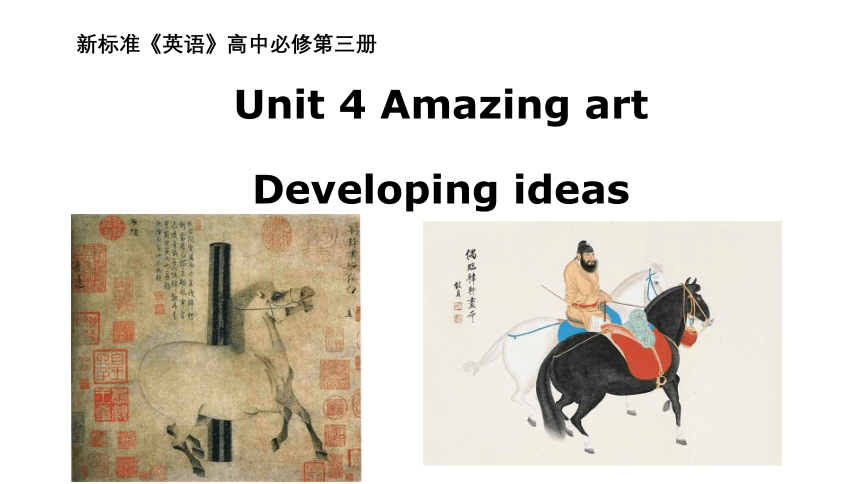 | |
| 格式 | pptx | ||
| 文件大小 | 1018.2KB | ||
| 资源类型 | 教案 | ||
| 版本资源 | 外研版(2019) | ||
| 科目 | 英语 | ||
| 更新时间 | 2021-06-20 22:01:49 | ||
图片预览


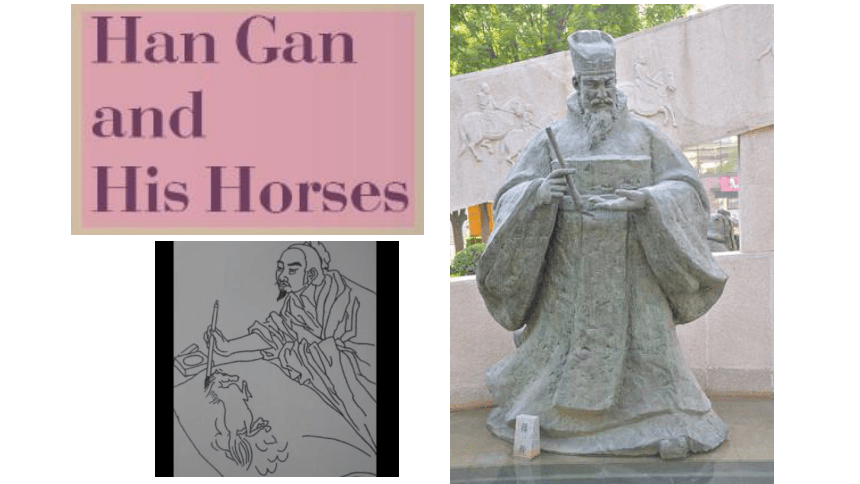
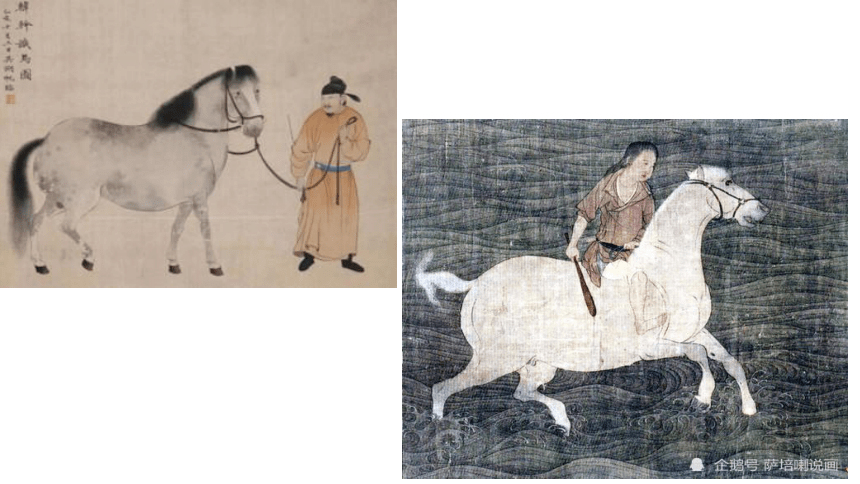
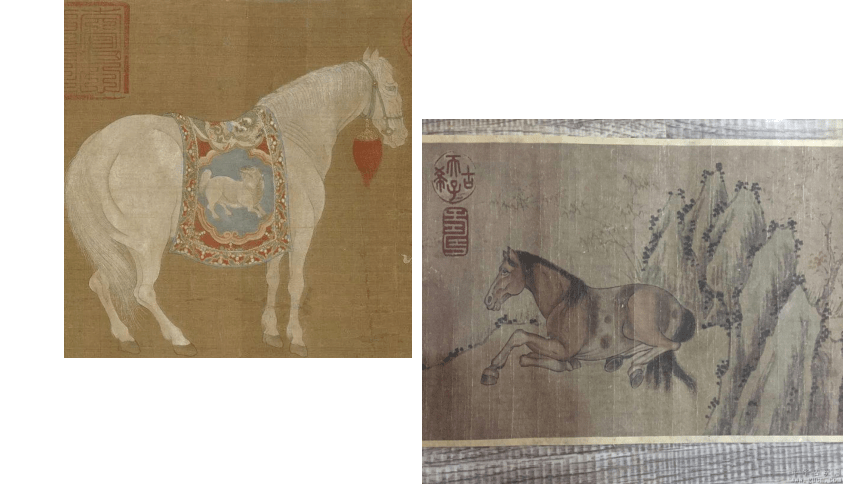

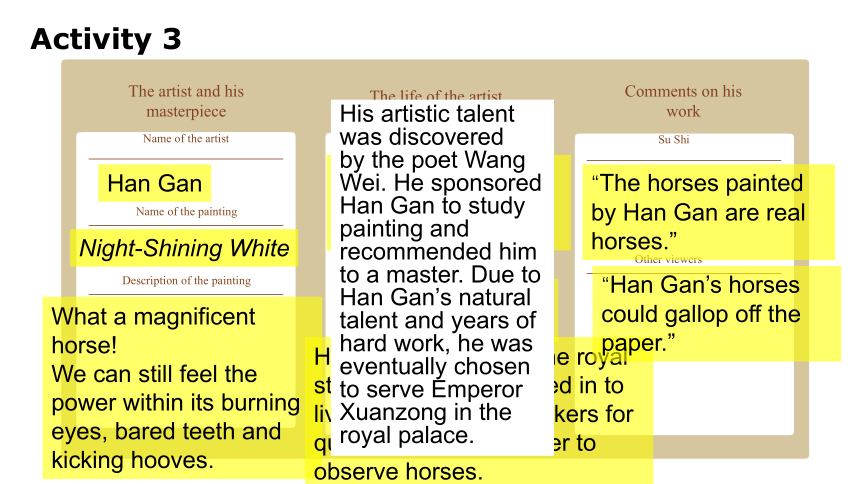
文档简介
Unit 4 Amazing art
Developing ideas
新标准《英语》高中必修第三册
Activity 1
Tick the words that you would use to describe horses.
Add any more you can think of.
calm
cute
fast
wild
brave
clever
loyal
strong
Now compare your choices with the rest of the class and share what you know about horses.
Activity 2
Read the passage and find out what it is about.
a An introduction to the Metropolitan Museum of Art.
b The story behind Night-Shining White.
c The famous artist Han Gan.
Activity 3
The artist and his masterpiece
Name of the artist
The life of the artist
Personal information
(birth, dynasty, etc)
Comments on his work
Su Shi
Name of the painting
How he became a painter
Other viewers
Description of the painting
What he did as a court painter
Han Gan
Night-Shining White
What a magnificent horse!
We can still feel the power within its burning eyes, bared teeth and
kicking hooves.
He was born into a poor family in the early Tang Dynasty.
His artistic talent was discovered
by the poet Wang Wei. He sponsored Han Gan to study painting and recommended him to a master. Due to Han Gan’s natural talent and years of hard work, he was eventually chosen
to serve Emperor Xuanzong in the royal palace.
He frequently visited the royal stables and even moved in to live with the stable workers for quite some time in order to observe horses.
“The horses painted by Han Gan are real horses.”
“Han Gan’s horses could gallop off the paper.”
His artistic talent was discovered
by the poet Wang Wei. He sponsored Han Gan to study painting and recommended him to a master. Due to Han Gan’s natural talent and years of hard work, he was eventually chosen
to serve Emperor Xuanzong in the royal palace.
Think & Share
1 What made Han Gan a successful painter?
2 What does Su Shi’s comment mean to you?
3 What can you learn from Han Gan’s way of painting?
4 Do you know of any other artists famous for painting animals? Introduce one to the class.
Activity 4
Think about what information to include.
Decide in what order you will introduce.
Introduce Han Gan and his painting to your group members.
Work in groups. Imagine you are a tour guide in the Metropolitan Museum of Art. Use the nformation in Activity 3 to talk about the life and work of Han Gan.
1 What a magnificent horse! Even after more than a thousand years have passed, we can still feel the power within its burning eyes, bared teeth and kicking hooves. Night-Sbiming White, now kept in New York's Metropolitan Museum of Art, is regarded as one of the most significant horse paintings in the history of Chinese art. Its artist, Han Gan, is known for his skill in capturing not only the physical features of the animal, but also its inner spirit and strength.
好一匹骏马!尽管已经走过千年的时光,我们还能从它炽烈的双眼、裸露的牙齿与舞动的马蹄中感觉到力量。《照夜白图》,现收藏于纽约大都会艺术博物馆,被认为是中国艺术史上最为重要的骏马图之一。它的创作者--画家韩干以其神形兼备的画马技艺闻名于世。
2 Born into a poor family in the early Tang Dynasty, the young Han Gan had to help support his family by working in a local wine shop. His artistic talent was discovered by accident when he was sent to the poet Wang Wei's house to collect payment for some wine. While waiting at the gate, Han Gan used a stick to draw pictures in the dirt and was seen by the poet himself. Wang Wei decided to sponsor the young man to study painting and recommended him to a master. Due to Han Gan's natural talent and years of hard work, he was eventually chosen to serve Emperor Xuanzong in the royal palace.
韩干出生于初唐时期的一个贫苦家庭,年少时不得不在酒肆帮工来维持家庭生计。有一次,他被派至诗人王维家收酒钱,绘画才能因机缘巧合被发现。当时,韩干在门口等候,他捡起一根木棒在土地上画画,正好被王维看到。王维决定资助这位年轻人学画,并将他引荐给了-位绘画大师。韩干本来就有天赋,加之多年勤学苦练,最终被召入皇宫为唐玄宗效力。
3 The Tang emperors were very fond of horses. This meant that the animal was a frequent subject for artists. At that time, the most common way to study horse painting was by copying the works of previous painters. Han Gan's method, however, was different - he observed the animal itself. He was a frequent visitor to the royal stables and even moved in to live with the stable workers for quite some time. The horses, whether resting or on the move, offered him plenty of inspiration. The more time he spent observing these animals, the more his understanding of them grew. Day after day, Han Gan painted the horses, his brush presenting every detail thar he saw with his own eyes.
唐代的皇帝十分喜爱骏马,马因此成为了画家笔下的常见主题。当时学习
画马最普遍的方法是临摹前人留下的画作。但韩干却采用了不同的方法一-他去观察真的马。他是皇家马厩的常客,甚至直接搬到马厩中与马夫同住了好一段时间。无论是静止休息的马还是动态行进的马,都给韩干带来很多灵感。他观察的时间越长,对马的了解程度就越深。韩干日复一日地练习画马,用画笔把眼睛观察到的每一处细节都呈现出来。
4 It is said that when the Emperor asked Han Gan to take a master of horse painting as his teacher, the artist replied,“I have my own teachers, Your Majesty. All the horses in your stables are my very teachers."
据说,皇帝曾让他选一位画马大师为师,韩干却回答:“我有自己的老师,陛下。您马厩里所有的马都是我的老师。”
5 Those who saw Han Gan's horse paintings all sang high praises for his unique skill, saying that his horses“could gallop off the paper". Even Su Shi, the famous poet of the Song Dynasty, expressed his admiration for Han Gan as a master of horse painting with the words, "The horses painted by Han Gan are real horses."
看过韩干的骏马图的人都对他独特的技艺赞赏有加,称他的马“跃然纸上”。就连宋朝的著名诗人苏轼都曾赞扬过韩干画马的卓越才能,他在诗中写道:“韩生画马真 是马。”
Developing ideas
新标准《英语》高中必修第三册
Activity 1
Tick the words that you would use to describe horses.
Add any more you can think of.
calm
cute
fast
wild
brave
clever
loyal
strong
Now compare your choices with the rest of the class and share what you know about horses.
Activity 2
Read the passage and find out what it is about.
a An introduction to the Metropolitan Museum of Art.
b The story behind Night-Shining White.
c The famous artist Han Gan.
Activity 3
The artist and his masterpiece
Name of the artist
The life of the artist
Personal information
(birth, dynasty, etc)
Comments on his work
Su Shi
Name of the painting
How he became a painter
Other viewers
Description of the painting
What he did as a court painter
Han Gan
Night-Shining White
What a magnificent horse!
We can still feel the power within its burning eyes, bared teeth and
kicking hooves.
He was born into a poor family in the early Tang Dynasty.
His artistic talent was discovered
by the poet Wang Wei. He sponsored Han Gan to study painting and recommended him to a master. Due to Han Gan’s natural talent and years of hard work, he was eventually chosen
to serve Emperor Xuanzong in the royal palace.
He frequently visited the royal stables and even moved in to live with the stable workers for quite some time in order to observe horses.
“The horses painted by Han Gan are real horses.”
“Han Gan’s horses could gallop off the paper.”
His artistic talent was discovered
by the poet Wang Wei. He sponsored Han Gan to study painting and recommended him to a master. Due to Han Gan’s natural talent and years of hard work, he was eventually chosen
to serve Emperor Xuanzong in the royal palace.
Think & Share
1 What made Han Gan a successful painter?
2 What does Su Shi’s comment mean to you?
3 What can you learn from Han Gan’s way of painting?
4 Do you know of any other artists famous for painting animals? Introduce one to the class.
Activity 4
Think about what information to include.
Decide in what order you will introduce.
Introduce Han Gan and his painting to your group members.
Work in groups. Imagine you are a tour guide in the Metropolitan Museum of Art. Use the nformation in Activity 3 to talk about the life and work of Han Gan.
1 What a magnificent horse! Even after more than a thousand years have passed, we can still feel the power within its burning eyes, bared teeth and kicking hooves. Night-Sbiming White, now kept in New York's Metropolitan Museum of Art, is regarded as one of the most significant horse paintings in the history of Chinese art. Its artist, Han Gan, is known for his skill in capturing not only the physical features of the animal, but also its inner spirit and strength.
好一匹骏马!尽管已经走过千年的时光,我们还能从它炽烈的双眼、裸露的牙齿与舞动的马蹄中感觉到力量。《照夜白图》,现收藏于纽约大都会艺术博物馆,被认为是中国艺术史上最为重要的骏马图之一。它的创作者--画家韩干以其神形兼备的画马技艺闻名于世。
2 Born into a poor family in the early Tang Dynasty, the young Han Gan had to help support his family by working in a local wine shop. His artistic talent was discovered by accident when he was sent to the poet Wang Wei's house to collect payment for some wine. While waiting at the gate, Han Gan used a stick to draw pictures in the dirt and was seen by the poet himself. Wang Wei decided to sponsor the young man to study painting and recommended him to a master. Due to Han Gan's natural talent and years of hard work, he was eventually chosen to serve Emperor Xuanzong in the royal palace.
韩干出生于初唐时期的一个贫苦家庭,年少时不得不在酒肆帮工来维持家庭生计。有一次,他被派至诗人王维家收酒钱,绘画才能因机缘巧合被发现。当时,韩干在门口等候,他捡起一根木棒在土地上画画,正好被王维看到。王维决定资助这位年轻人学画,并将他引荐给了-位绘画大师。韩干本来就有天赋,加之多年勤学苦练,最终被召入皇宫为唐玄宗效力。
3 The Tang emperors were very fond of horses. This meant that the animal was a frequent subject for artists. At that time, the most common way to study horse painting was by copying the works of previous painters. Han Gan's method, however, was different - he observed the animal itself. He was a frequent visitor to the royal stables and even moved in to live with the stable workers for quite some time. The horses, whether resting or on the move, offered him plenty of inspiration. The more time he spent observing these animals, the more his understanding of them grew. Day after day, Han Gan painted the horses, his brush presenting every detail thar he saw with his own eyes.
唐代的皇帝十分喜爱骏马,马因此成为了画家笔下的常见主题。当时学习
画马最普遍的方法是临摹前人留下的画作。但韩干却采用了不同的方法一-他去观察真的马。他是皇家马厩的常客,甚至直接搬到马厩中与马夫同住了好一段时间。无论是静止休息的马还是动态行进的马,都给韩干带来很多灵感。他观察的时间越长,对马的了解程度就越深。韩干日复一日地练习画马,用画笔把眼睛观察到的每一处细节都呈现出来。
4 It is said that when the Emperor asked Han Gan to take a master of horse painting as his teacher, the artist replied,“I have my own teachers, Your Majesty. All the horses in your stables are my very teachers."
据说,皇帝曾让他选一位画马大师为师,韩干却回答:“我有自己的老师,陛下。您马厩里所有的马都是我的老师。”
5 Those who saw Han Gan's horse paintings all sang high praises for his unique skill, saying that his horses“could gallop off the paper". Even Su Shi, the famous poet of the Song Dynasty, expressed his admiration for Han Gan as a master of horse painting with the words, "The horses painted by Han Gan are real horses."
看过韩干的骏马图的人都对他独特的技艺赞赏有加,称他的马“跃然纸上”。就连宋朝的著名诗人苏轼都曾赞扬过韩干画马的卓越才能,他在诗中写道:“韩生画马真 是马。”
